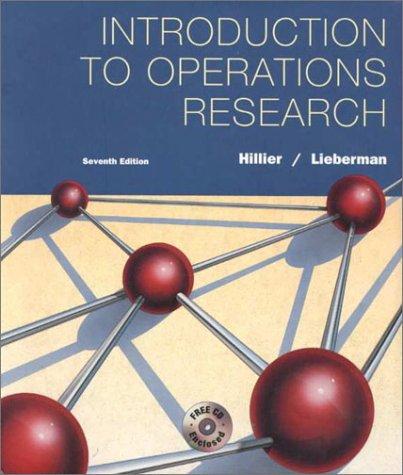Reconsider Eddies Bicycle Shop described in Prob. 22.4-7. Forty percent of the bicycles require only a minor
Question:
Reconsider Eddie’s Bicycle Shop described in Prob. 22.4-7.
Forty percent of the bicycles require only a minor repair.
The repair time for these bicycles has a uniform distribution between 0 and 1 hour. Sixty percent of the bicycles require a major repair. The repair time for these bicycles has a uniform distribution between 1 hour and 2 hours. You now need to estimate the mean of the overall probability distribution of the repair times for all bicycles by using the following alternative methods.
(a) Use the uniform random numbers—0.7256, 0.0817, and 0.4392—to simulate whether each of three bicycles requires minor repair or major repair. Then use the uniform random numbers—0.2243, 0.9503, and 0.6104—to simulate the repair times of these bicycles. Calculate the average of these repair times to estimate the mean of the overall distribution of repair times.
(b) Draw the cumulative distribution function (CDF) for the overall probability distribution of the repair times for all bicycles.
(c) Use the inverse transformation method with the latter three uniform random numbers given in part
(a) to generate three random observations from the overall distribution considered in part (b). Calculate the average of these observations to estimate the mean of this distribution.
(d) Repeat part
(c) with the complements of the uniform random numbers used there, so the new uniform random numbers are 0.7757, 0.0497, and 0.3896.
(e) Use the method of complementary random numbers to estimate the mean of the overall distribution of repair times by combining the random observations from parts
(c) and (d).
(f) The true mean of the overall probability distribution of repair times is 1.1. Compare the estimates of this mean obtained in parts (a), (c), (d), and (e). For the method that provides the closest estimate, give an intuitive explanation for why it performed so well.
E (g) Formulate a spreadsheet model to apply the method of complementary random numbers. Use 300 uniform random numbers to generate 600 random observations from the distribution considered in part
(b) and calculate the average of these random observations. Compare this average with the true mean of the distribution.
(h) The drawbacks of the approach described in part
(a) are that
(1) it does not ensure that the repair times for both minor repairs and major repairs are adequately sampled and (2) it requires two uniform random numbers to generate each random observation of a repair time. To overcome these drawbacks, combine stratified sampling and the method of complementary random numbers by using the first three uniform random numbers given in part
(a) to generate six random minor repair times and the other three uniform random numbers to generate six random major repair times. Calculate the resulting estimate of the mean of the overall distribution of repair times.
Step by Step Answer:

Introduction To Operations Research
ISBN: 9780072321692
7th Edition
Authors: Frederick S. Hillier, Gerald J. Lieberman




